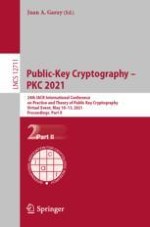2021 | OriginalPaper | Buchkapitel
An Efficient and Generic Construction for Signal’s Handshake (X3DH): Post-Quantum, State Leakage Secure, and Deniable
verfasst von : Keitaro Hashimoto, Shuichi Katsumata, Kris Kwiatkowski, Thomas Prest
Erschienen in: Public-Key Cryptography – PKC 2021
Aktivieren Sie unsere intelligente Suche, um passende Fachinhalte oder Patente zu finden.
Wählen Sie Textabschnitte aus um mit Künstlicher Intelligenz passenden Patente zu finden. powered by
Markieren Sie Textabschnitte, um KI-gestützt weitere passende Inhalte zu finden. powered by
